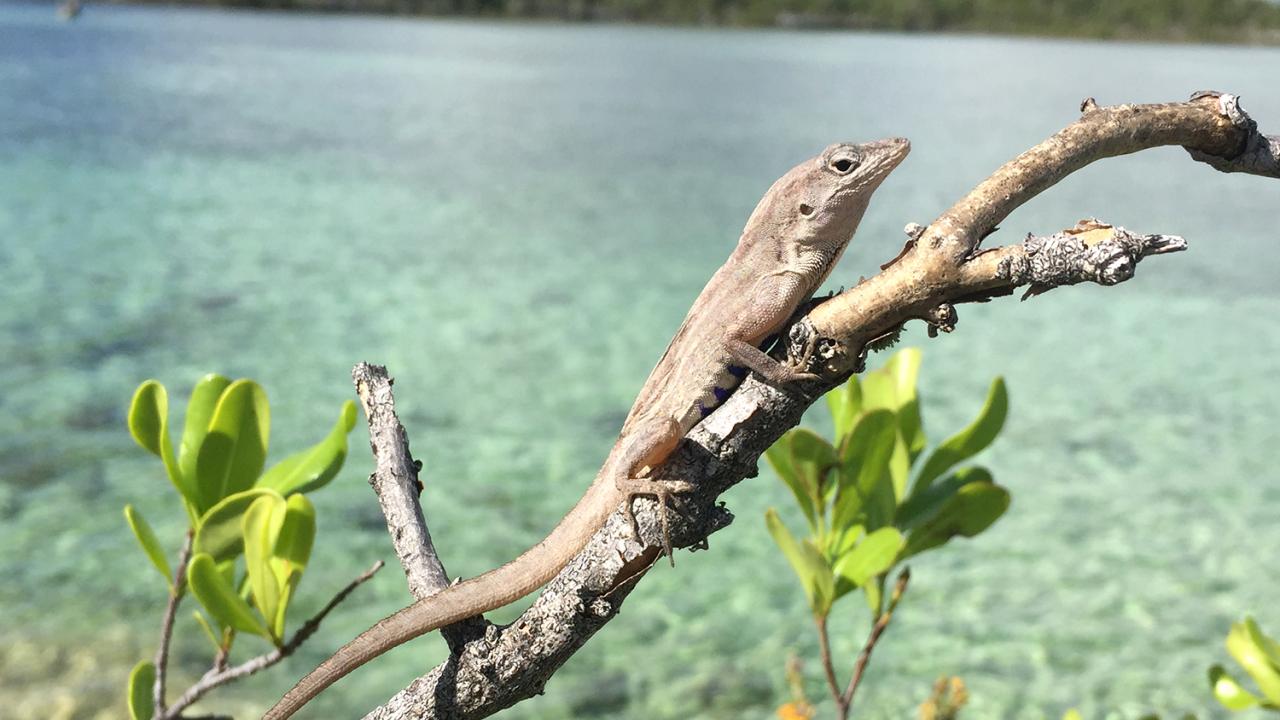
Risk and Reward: Lizards Demonstrate Role of Natural Selection in Shaping Behavior
Research Summary
- Brown anole risk-taking behavior was the greatest predictor of survival on predator islands
- Island environments provide ideal, controlled settings for scientific experiments
- Study findings pose new avenue for exploring natural selection's effect on behavior
Tiny lizards in the Bahamas are providing scientists with new insights into evolution in isolated environments. In a new paper in the journal Science, biologists analyzed the risk-taking actions of the brown anole (Anolis sagrei) to better understand how animal behavior is influenced by natural selection.
Researchers from UC Davis, Harvard University, University of Missouri and University of Rhode Island, relocated 273 brown anole lizards to eight isolated islands to study their ability to survive with and without a top predator, the curly-tail lizard (Leiocephalus carinatus). They were surprised to discover that under increased predation, behavioral traits were more significant than morphological traits, or anatomy, as a predictor of survival for the female lizards.
“As we know, some animals are more risk adverse than others,” said Distinguished Professor Thomas Schoener, Department of Evolution and Ecology. “But we were surprised to find that individual A. sagrei differed in such behavior, and that these differences were consistent over time.”

Life as an anole
For the small but nimble brown anole, venturing from the safety of a tree perch is dangerous, but necessary for finding ground-dwelling prey. Both the time spent on the ground as well as the willingness to explore new areas raise survival concerns. The brown anole is faced with a risk analysis scenario: search further and find more food but increase the chance of encountering a predator, or explore slowly and thoroughly, but increase time spent in the danger zone.
Male brown anoles, which are significantly larger than females, are less likely to be eaten by the predatory curly-tail lizard. Previous research demonstrated that female brown anoles with longer legs could move quicker on the ground than shorter-legged members of the species. Moreover, those that frequently spent time on the ground are more likely to have longer legs.

On islands with predators, the brown anole’s willingness to take risks was a top predictor of survival, not leg length. But on islands without predators, those with longer legs were more likely to survive. Longer legs also aid in more efficient exploration of the environment.
These observations demonstrate that natural selection can shape behavioral traits, which may lead to adaptations unique to a particular environment. Due to the challenges of analyzing behavior, most evolutionary research favors the study of morphology. But in this case, the presence of different islands helped make the case for behavior as a key predictor of survivability.
Islands, the ideal environments
During the four-month study, researchers split the brown anoles up among eight islands, four with predators and four without. Anoles were tracked with alphanumeric tags. As expected, the survival rate was much lower on predator islands. Observations revealed that brown anoles on predator islands used the ground 17 percent less often than those on predator-free islands, and tree perch height was twice as high on predator islands.
Schoener sees islands as ideal settings for behavioral experiments, as they provide natural settings that are largely isolated from outside influences. “Our experiments on islands simulate, yet speed up natural processes,” he said.
The risk-taking behavior of brown anoles has large-ranging implications throughout the islands’ food webs. Increases or decreases in brown anole numbers affect the populations of the herbivores they consume, which impact the plants of the island. Further behavioral studies have the potential to change what biologists understand about natural selection.
Until now, we had never looked at natural selection on behavior,” said Schoener. “It opens up a new avenue of investigation.”
The paper’s authors include Oriol Lapiedra of Harvard University, Manuel Leal, University of Missouri, and Jason Kolbe, University of Rhode Island. Funding for the research was provided by the Agency for Management of University and Research Grants of Catalonia, Spain, Harvard University, University of Rhode Island and a National Geographic Explorer Grant.
